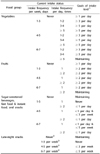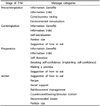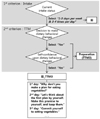1. Jung YH, Ko SJ, Lim H. The socioeconomic cost of adolescent obesity. Health Soc Welf Rev. 2010; 30:195–219.

2. Whitaker RC, Wright JA, Pepe MS, Seidel KD, Dietz WH. Predicting obesity in young adulthood from childhood and parental obesity. N Engl J Med. 1997; 337:869–873.

3. Lalonde M. A New Perspective on the Health of Canadians: a Working Document. Ottawa: Government of Canada;1974.
4. Kim YS, Shin JK, Hong IS, Kim SH, Chang UJ. Weight control program through the fortification of food consumption monitoring on obese female college students-using smart-phone with real time communication application. Korean J Community Nutr. 2011; 16:697–705.

5. Verhoeven F, van Gemert-Pijnen L, Dijkstra K, Nijland N, Seydel E, Steehouder M. The contribution of teleconsultation and videoconferencing to diabetes care: a systematic literature review. J Med Internet Res. 2007; 9:e37.

6. Kim YA. Our Class Revolution: Current situation of Smart Learning and Development Plan (OR2011-02-7). Seoul: Korean Educational Development Institute;2011.
7. Burke LE, Styn MA, Sereika SM, Conroy MB, Ye L, Glanz K, Sevick MA, Ewing LJ. Using mHealth technology to enhance self-monitoring for weight loss: a randomized trial. Am J Prev Med. 2012; 43:20–26.
8. de Niet J, Timman R, Bauer S, van den Akker E, de Klerk C, Kordy H, Passchier J. Short message service reduces dropout in childhood obesity treatment: a randomized controlled trial. Health Psychol. 2012; 31:797–805.

9. Turner-McGrievy GM, Beets MW, Moore JB, Kaczynski AT, Barr-Anderson DJ, Tate DF. Comparison of traditional versus mobile app self-monitoring of physical activity and dietary intake among overweight adults participating in an mHealth weight loss program. J Am Med Inform Assoc. 2013; 20:513–518.

10. Woolford SJ, Clark SJ, Strecher VJ, Resnicow K. Tailored mobile phone text messages as an adjunct to obesity treatment for adolescents. J Telemed Telecare. 2010; 16:458–461.

11. Kim JW, Lee EJ. Current status of dietary education applications (App) as a smart education material. J Korean Pract Arts Educ. 2013; 26:81–110.
12. Prochaska JO, DiClemente CC, Norcross JC. In search of how people change. Applications to addictive behaviors. Am Psychol. 1992; 47:1102–1114.

13. Prochaska JO, DiClemente CC. Stages and processes of self-change of smoking: toward an integrative model of change. J Consult Clin Psychol. 1983; 51:390–395.

14. Prochaska JO, Redding CA, Evers KE. The transtheoretical model and stages of change. In : Glanz K, Rimer BK, Viswanath K, editors. Health Behavior and Health Education. San Francisco (CA): John Wiley & Sons;2008. p. 97–122.
15. Kim NH, Jun SS, Kim YH, Kim JS, Hwang SK. Application of the transtheoretical model to obese adolescents' exercise behavior change stages. J Korean Soc Health Educ Promot. 2005; 22:103–115.
16. Lee YM, Park HS. A study on the stage of change in exercise behaviors, exercise self efficacy, depression and stress in middle aged women. Korean J Women Health Nurs. 2004; 10:218–225.

17. Cho SY. Comparison of process of change, self-efficacy, decisional balance and personality by the stages of exercise behavior in middle-aged women [master's thesis]. Suwon: Ajou University;2010. –. .
18. Kim YH, Kim JS, Kim MS. Effectiveness of public health center smoking cessation counseling program using the transtheoretical model. J Korean Acad Nurs. 2009; 39:469–479.

19. Kim SO. The development and effects of a medication adherence intervention program for hypertensive patients. J Korean Acad Community Health Nurs. 2011; 22:342–354.

20. Yoo CY. A study of effectiveness of group program for domestic violent offender's problem drinking. Korean J Soc Welf Stud. 2002; 20:85–116.
21. Oh HS, Kim YR. Changing mechanisms corresponding to the changing stages of smoking cessation. J Nurs Acad Soc. 1996; 26:820–832.

22. Carvalho de Menezes M, Bedeschi LB, Santos LC, Lopes AC. Interventions directed at eating habits and physical activity using the Transtheoretical Model: a systematic review. Nutr Hosp. 2016; 33:586.

23. Free C, Phillips G, Galli L, Watson L, Felix L, Edwards P, Patel V, Haines A. The effectiveness of mobile-health technology-based health behaviour change or disease management interventions for health care consumers: a systematic review. PLoS Med. 2013; 10:e1001362.

24. Kim HH, Seo HJ. HealthTWITTER initiative: design of a social networking service based tailored application for diabetes self-management. Healthc Inform Res. 2014; 20:226–230.

25. Lee MK, Park HA, Yun YH, Chang YJ. Development and formative evaluation of a web-based self-management exercise and diet intervention program with tailored motivation and action planning for cancer survivors. JMIR Res Protoc. 2013; 2:e11.

26. Partridge SR, McGeechan K, Hebden L, Balestracci K, Wong AT, Denney-Wilson E, Harris MF, Phongsavan P, Bauman A, Allman-Farinelli M. Effectiveness of a mHealth lifestyle program with telephone support (TXT2BFiT) to prevent unhealthy weight gain in young adults: randomized controlled trial. JMIR Mhealth Uhealth. 2015; 3:e66.

27. Kang MH, Lee JS, Kim HY, Kwon S, Choi YS, Chung HR, Kwak TK, Cho YH. Selecting items of a food behavior checklist for the development of nutrition quotient (NQ) for children. Korean J Nutr. 2012; 45:372–389.

28. Centers for Disease Control and Prevention (KR). National Dietary Guidelines for Children. Seoul: Centers for Disease Control and Prevention;2010.
29. Lin PH, Wang Y, Levine E, Askew S, Lin S, Chang C, Sun J, Foley P, Wang H, Li X, Bennett GG. A text messaging-assisted randomized lifestyle weight loss clinical trial among overweight adults in Beijing. Obesity (Silver Spring). 2014; 22:E29–E37.

30. Ministry of Health and Welfare, Korea Centers for Disease Control and Prevention. Korea Health Statistics 2010: Korea National Health and Nutrition Examination Survey (KNHANES V-1). Cheongwon: Korea Centers for Disease Control and Prevention;2011.
31. Andrés A, Juana G, Carmina S. The transtheoretical model and obesity: a bibliometric study. Scientometrics. 2007; 73:289–301.

32. Kim BH, Lim H. Effects of customized nutritional education ‘change 10 habits’ program according to stage of behavior change in mildly obese adults. J Korean Diet Assoc. 2015; 21:215–226.

33. Logue E, Sutton K, Jarjoura D, Smucker W, Baughman K, Capers C. Transtheoretical model-chronic disease care for obesity in primary care: a randomized trial. Obes Res. 2005; 13:917–927.

34. Woolford SJ, Clark SJ, Strecher VJ, Resnicow K. Tailored mobile phone text messages as an adjunct to obesity treatment for adolescents. J Telemed Telecare. 2010; 16:458–461.











 PDF
PDF ePub
ePub Citation
Citation Print
Print







 XML Download
XML Download